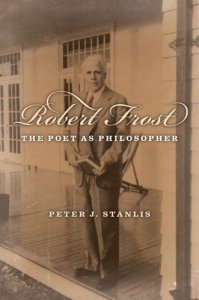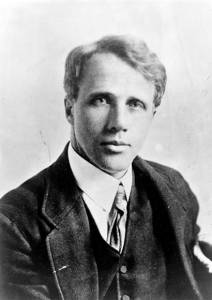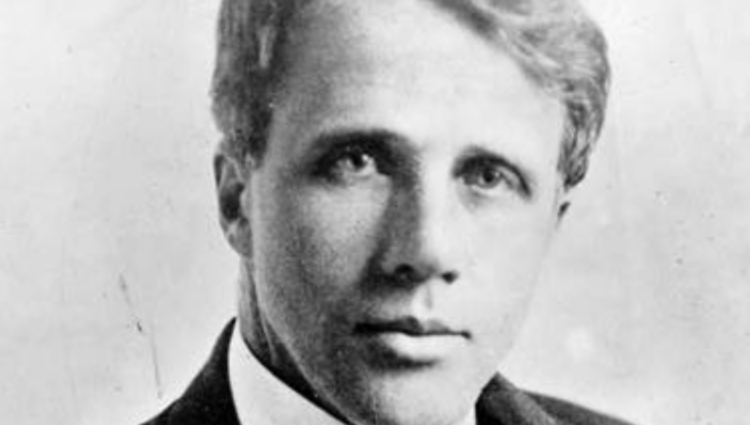The conservatism of Robert Frost was rooted in his tendency to view existence as inherently paradoxical. Frost carefully crafted and honed metaphor as a device to express such tensions in suggestive rather than didactic ways, which sometimes resulted in critical misinterpretations that deny the importance of the metaphysical in his verse.
Robert Frost: The Poet as Philosopher, by Peter J. Stanlis (350 pages, ISI Books, 2007)
 Peter J. Stanlis contends that Robert Frost’s dualistic, “unsystematic philosophical view of reality” is the “foremost single element that scholars and literary critics need to consider in any study of his life and thought, including the themes of his poetry” (1). This assertion is, arguably, an overstatement, but, as for many Frost scholars, Stanlis’s bet noir is Frost’s official biographer, Lawrance Thompson, who “should have understood Frost well from all the sources available to him,” but whose account of Frost represents an “almost inverse ratio between the facts of Frost’s life, poetry, and talk and Thompson’s understanding of them” (9). Thompson, and other “critics whose beliefs are centered in an optimistic monism,” failed to “comprehend Frost’s dualism,” and often interpreted the bard’s life and art through the lens of “abnormal psychology,” resulting in “character assassination” and “severe misinterpretation of his work” (11). Stanlis wants to correct these alleged distortions. It is unlikely that his study will have a significant influence on biographical studies of Frost, which will continue to focus on actions and human relationships, but it will have a noteworthy impact on examinations of his poetry, which is the fundamental reason readers are interested in Frost.
Peter J. Stanlis contends that Robert Frost’s dualistic, “unsystematic philosophical view of reality” is the “foremost single element that scholars and literary critics need to consider in any study of his life and thought, including the themes of his poetry” (1). This assertion is, arguably, an overstatement, but, as for many Frost scholars, Stanlis’s bet noir is Frost’s official biographer, Lawrance Thompson, who “should have understood Frost well from all the sources available to him,” but whose account of Frost represents an “almost inverse ratio between the facts of Frost’s life, poetry, and talk and Thompson’s understanding of them” (9). Thompson, and other “critics whose beliefs are centered in an optimistic monism,” failed to “comprehend Frost’s dualism,” and often interpreted the bard’s life and art through the lens of “abnormal psychology,” resulting in “character assassination” and “severe misinterpretation of his work” (11). Stanlis wants to correct these alleged distortions. It is unlikely that his study will have a significant influence on biographical studies of Frost, which will continue to focus on actions and human relationships, but it will have a noteworthy impact on examinations of his poetry, which is the fundamental reason readers are interested in Frost.
 Over a long and accomplished career, Peter J. Stanlis has often worked at the intersection of literature, philosophy, and political philosophy, and this emphasis is evident in Robert Frost: The Poet as Philosopher, a study that explores Frost’s relationship to developments in the sciences, the humanities, and politics from the age of Charles Darwin to the time of John F. Kennedy’s presidency. Stanlis met Frost at the Bread Loaf Summer School in 1939, and maintained a friendship with him until the poet died in 1963. As Timothy Steele points out in the book’s introduction, unlike other major poets—Yeats, Stevens, Pound, Williams, Eliot—Frost wrote scant criticism and engaged in little “formal self-commentary” (i), making systematic study of his thought difficult. Stanlis makes up for this limitation by relying on “records of private talks with the poet, interviews, and comments made by Frost during his poetry readings,” a tactic with potential pitfalls, but which works surprisingly well. Stanlis claims that from “around 1913 until Robert Frost’s death in January 1963, almost everyone who knew him personally agreed that he was among the most brilliant, provocative, learned, and original conversationalists of the twentieth century” (xi). The list of Frost’s interlocutors is impressive, and includes John Ciardi, Louis Mertins, Richard Poirier, Richard Wilbur, and Frost’s longtime friend Louis Untermeyer. Their recollections of Frost’s thoughts are remarkably consistent. What emerges is a convincing portrait of Frost as a “liberal conservative,” a man who by nature, nurture, and self-education was inclined to resist dogma and ideology, but who was also patriotic, religiously inclined, and who believed in social and economic systems that stressed a strong correlation between individual achievements and rewards.
Over a long and accomplished career, Peter J. Stanlis has often worked at the intersection of literature, philosophy, and political philosophy, and this emphasis is evident in Robert Frost: The Poet as Philosopher, a study that explores Frost’s relationship to developments in the sciences, the humanities, and politics from the age of Charles Darwin to the time of John F. Kennedy’s presidency. Stanlis met Frost at the Bread Loaf Summer School in 1939, and maintained a friendship with him until the poet died in 1963. As Timothy Steele points out in the book’s introduction, unlike other major poets—Yeats, Stevens, Pound, Williams, Eliot—Frost wrote scant criticism and engaged in little “formal self-commentary” (i), making systematic study of his thought difficult. Stanlis makes up for this limitation by relying on “records of private talks with the poet, interviews, and comments made by Frost during his poetry readings,” a tactic with potential pitfalls, but which works surprisingly well. Stanlis claims that from “around 1913 until Robert Frost’s death in January 1963, almost everyone who knew him personally agreed that he was among the most brilliant, provocative, learned, and original conversationalists of the twentieth century” (xi). The list of Frost’s interlocutors is impressive, and includes John Ciardi, Louis Mertins, Richard Poirier, Richard Wilbur, and Frost’s longtime friend Louis Untermeyer. Their recollections of Frost’s thoughts are remarkably consistent. What emerges is a convincing portrait of Frost as a “liberal conservative,” a man who by nature, nurture, and self-education was inclined to resist dogma and ideology, but who was also patriotic, religiously inclined, and who believed in social and economic systems that stressed a strong correlation between individual achievements and rewards.
Stanlis’s description of Frost as a “liberal conservative” is particularly useful. In the late 1930s, after the appearance of A Further Range (1936), Frost was attacked by a variety of critics. The volume was awarded the Pulitzer Prize (the third of four he won), but R. P. Blackmur—usually a wonderfully capable formalist—joined Malcolm Cowley and others in chastising Frost for a lack of technical innovation and thematic complexity and unfavorably compared him to high modernists such as Eliot, Stevens, and Pound. Critics on the political left—including Newton Arvin, F. O. Matthiessen and Rolfe Humphries—labeled him a political reactionary and/or an escapist. Stanlis does not delve deeply into the history of Frost’s critical reception, and many critics have long since refuted such at- tacks, but Stanlis’s insights add another dimension to the dynamic, helping more fully to unveil how a tension between science and religion informs Frost’s deceptively simple verse.
Stanlis shows that Frost’s liberal conservatism was rooted in his tendency to view existence as inherently paradoxical. This is nothing new, of course. As early as 1951 John Crowe Ransom—a champion of paradox, contradiction, and irony—ranked Frost as one of only four “major” poets writing in English during the first half of the twentieth century. But Stanlis details the depth of Frost’s learning more than any other previous critic and reveals how it underpins his verse. He shows that from a young age Frost was a voracious reader whose interests ranged far beyond the strictly literary, encompassing philosophy, religion, politics, theories of education, and, most importantly for Stanlis’s purposes, science. Frost often expressed the conviction that science was one of the humanities, a form of inquiry whose findings should be modified and supplemented by humanistic discourse. Stanlis establishes Frost as a philosophical dualist who distrusted any monism based on materialism or idealism and who believed that truth could be approached most closely by considering tensions between various epistemologies. Frost carefully crafted and honed metaphor as a device to express such tensions in suggestive rather than didactic ways, which sometimes resulted in critical misinterpretations that deny the importance of the metaphysical in his verse. Stanlis convincingly conveys Frost’s engagement with the spiritual, and in this way helps open up new avenues of interpretation.
Stanlis cites Frost’s well-documented sojourn in England from 1912 to 1915 as a time of sea-change in the poet’s aesthetic and philosophical assumptions. While critics and biographers have documented the transformations Frost underwent as a versifier between A Boy’s Will (1912) and North Of Boston (1914), Stanlis feels that the aesthetic makeover was “merely preliminary to a much more important lifelong transmutation in Frost’s total philosophy as a dualist, changes which encompassed his beliefs regarding science, religion, history, the humanities, education, society, and politics” (14). Frost’s “lifelong transmutation” involves his identification of “matter and spirit as the two basic elements in his dualistic conception of all reality” (19). For Frost, theories based on either a monism of spirit or of matter resulted in “fanaticism and a belief in absolutism” that in their most pernicious forms provided the rationale for the “totalitarian politics of the twentieth century” (25).
Stanlis’s early chapters go on to deal with Frost’s reactions to various materialistic theories, and half of the book is devoted to thinkers Frost admired or disdained. Stanlis shows that Frost’s decades-long engagement with Darwin’s thought was profound and multidimensional, and that he “clearly believed that new scientific theories or discoveries, which were always subject to change, did not destroy basic and enduring revealed religious truths,” but in- stead “compelled mankind to modify its understanding of them” (31). For Frost, human “evolution was an open-ended process, like artistic creativity,” which combined “emotion, reason, intuition, the senses, imagination, conscious and unconscious memory, free will, and courage.” Creative evolution “ultimately involves the active and productive achievements of individuals and the human species that give shape and direction to culture and enduring civilization” (53).
The poet felt that the “truths regarding matter as revealed by science and the truths of spirit as contained in religion are among the great metaphors by which mankind lives and finds meaning,” and he believed that art, and poetry in particular, could utilize metaphors to help tease out the tensions and connections between the two branches of knowledge (32).
Frost came to think that social Darwinists had misrepresented theories of creative evolution as much as “literal-minded fundamentalists who condemned” Darwin’s “theory as a denial of Genesis and all revealed religion” (38). For Frost, Thomas Henry Huxley, his son Leonard, grandsons Julian and Aldous, and various followers, including Herbert Spencer and H. G. Wells, provided a sharp contrast to Darwin. Though these thinkers have often been closely identified with Darwin, Frost thought that they engaged in “facile spieling” and lacked Darwin’s intelligence, flexibility, and respect for religion. Frost thought that Huxley and company placed much too strong an emphasis on biology and rationality. Notably, Stanlis aligns Frost with Pascal, who stressed the importance of intuition and the relationship between the imagination, reason, and spirituality. To Frost, Darwin’s theories provided a supplement to creative evolution and were part of the process of distinguishing the ways in which human nature differed from all other forms of life on Earth. They pointed towards the recognition of an “open-ended universe” and a rejection or modification of comparatively static paradigms such as the great chain of being.
Einstein’s theories were also central for Frost in this regard. Stanlis devotes a chapter to examining how Einstein’s thought “confirmed and enriched Frost’s own philosophical dualism” (141) and how he used the “scientist’s ideas and metaphors regarding time and curved-space in some of his poems” (142). Most importantly, Stanlis illustrates how Frost’s “conception of knowledge and understanding as metaphor” related to the idea of an open-ended universe by locating the theory “within the historical context of all previous theories that determined the worldview of mankind in various epochs” (168). In the next chapter, “Frost and Religion: The two Masques,” Stanlis examines Frost’s two long poems (“A Masque of Mercy” and “A Masque of Reason”) to explore how Frost’s “views towards the ambiguities in traditional religion and modern science” form the philosophical basis for much of his verse (168).
The second half of Robert Frost: The Poet as Philosopher is devoted to Frost’s theories of education, his thoughts on the relationship between the individual and society, and to his politics. These chapters are aimed at countering Thompson’s portrait of Frost as an egotistical, right wing, social Darwinist who treated his family brutally and who was competitive with other poets to a near maniacal extent. As I have mentioned, Stanlis’s explorations of Frost’s philosophical assumptions probably won’t make much of a difference in this regard—Jay Parini’s relatively recent biography addresses such matters more effectively. But Stanlis’s insights into Frost’s negotiations with various intellectual traditions will be of great help assessing Frost’s relationship to literary history and other twentieth-century poets, a path the book could have pursued more fully.
Though Ezra Pound served as Frost’s editor, Frost was not part of the American expatriate group of high modernists who came into prominence during the first half of the twentieth century, a point that Pound famously underscored by condescendingly calling Frost “VURRY Amur’ kin.” Instead, studies often couple him with E. A. Robinson and William Carlos Williams, poets who shunned an experimental, international style in favor of an American idiom and conversational language. Frost is also commonly associated with his New England predecessors—Emerson, Thoreau, Whittier, Dickinson—and regarded as a late romantic, a post- Darwinian regionalist who replaced transcendentalist metaphysics with pessimism and darkness. Robert Frost: The Poet as Philosopher paves the way for fuller examinations of Frost’s relationship to this literary tradition and especially to later twentieth-century poets—Richard Hugo, Mary Oliver, Louise Gluck, Charles Wright, Ellen Bryant Voigt—who have foregrounded the use of landscapes in their verse and resisted ideological formulations, be it Eliot’s theism, Pound’s reactionary economic and cultural theories, Allen Ginsberg’s countercultural socialism, Adrianne Rich’s feminism, or L=A=N=G=U=A=G=E poets’ Marxism.
Stanlis is to be congratulated for extending the intellectual framework for understanding Frost’s verse. Consider the conclusion of Frost’s magnificent poem “The Onset” within the tantalizing dynamic of Frost’s dualistic approach. In the last stanza naturalism and Christianity tug at one another as the narrator contemplates humans’ hope for an afterlife by comparing it with the seasons of nature:
Yet all the precedent is on my side:
I know that winter death has never tried
The earth but it has failed: the snow may heap
In long storms an undrifted four feet deep
As measured against maple, birch, and oak,
It cannot check the peeper’s silver croak;
And I shall see the snow all go down hill
In water of a slender April rill
That flashes tail through last year’s withered brake
And dead weeds, like a disappearing snake.
Nothing will be left white but here a birch,
And there a clump of houses with a church.
Republished with the gracious permission of Humanitas (2008).
This essay was first published here in November 2014.
The Imaginative Conservative applies the principle of appreciation to the discussion of culture and politics—we approach dialogue with magnanimity rather than with mere civility. Will you help us remain a refreshing oasis in the increasingly contentious arena of modern discourse? Please consider donating now.
The featured image is a photograph of Robert Frost (1910s) and is in the public domain, courtesy of Wikimedia Commons.












